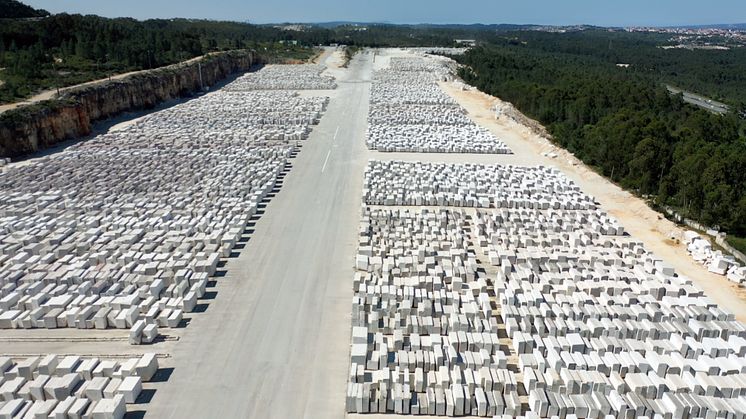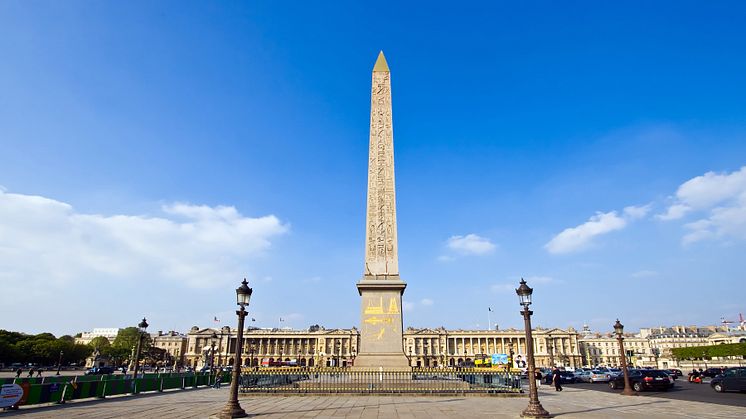
Press release -
Construction slump meets natural stone market: Is the crisis set in stone?
Whether it’s houses, staircases, or squares: natural stones are the foundation of everyday life. Yet, the global construction industry faces challenges such as rising raw material prices and supply chain issues, leading to cost increases and project delays. These factors directly impact the natural stone industry, where demand for materials like limestone and granite is declining, yet paradoxically, prices are rising. Current market developments and why stock clearance auctions can be an opportunity for construction companies...
Rising building material prices, material shortages, supply chain issues, labour shortages, and high inflation rates: The outlook for the global construction industry in 2024 remains uncertain as these factors lead to rising construction costs, project delays, and low investment willingness.
Contrasts between Europe and Asia in the construction industry 2024
Despite challenging conditions, a growth of 3% is expected this year in Europe, as individual countries support their economies through targeted subsidies. While residential construction continues to suffer, commercial construction and public construction show slight signs of recovery. In contrast, Germany, once the growth engine of the construction industry in Europe, is expected to see a decline in revenue and employment.
In China, one of the world’s largest construction nations and an important trading partner for European construction machinery and building materials companies, the downturn in the real estate sector is noticeable. While in Europe, rising construction costs, low interest rates, and an imbalance between supply and demand are driving up property prices, in China, regulatory interventions, economic decline, and financial problems of real estate developers are leading to a price decline. Nevertheless, the Asian region remains the largest construction market in 2024 due to its dynamic economies and population growth.
Weak construction industry with consequences for the natural stone industry
The general restraint in construction has direct effects on the natural stone industry. Natural stones such as limestone, granite, and marble are central building materials whose demand is suffering under the current economic situation. Yet, prices for natural stones are rising.
This apparent paradox can be explained by several factors: It began with the COVID-19 pandemic. The global blockades had massive impacts on the production and transport of materials. These disruptions led to a shortage of materials on the market. After the pandemic-related failures, there was a strong backlog in many industries, including the construction industry. This increased demand met a limited supply, especially for natural stones, where production capacities are limited. Problems such as container shortages and delays in ports have remained. Especially the natural stone industry is heavily dependent on efficient supply chains, as many natural stones are mined in large blocks and must be transported internationally. Rising transport costs contribute to the scarcity and thus to rising prices.
Global leaders in the natural stone industry
The main players in the global natural stone industry are primarily located in countries rich in natural stone resources. China, India, and Turkey dominate the market both in production and export of natural stone. Together, they are responsible for more than half of the global natural stone production.
Although exports have declined in recent years, China remains the largest producer of blocks. About one-third of all natural stone blocks are mined here. The Chinese buyer's market increasingly focuses on higher-quality stones to serve the domestic market driven by major construction projects and urban development. India is also a heavyweight in the natural stone sector, especially as an exporter. The country is particularly known for its granite deposits.
In Europe, Italy, Portugal, and Spain play a leading role in the natural stone industry, not only in extraction but also in processing and trading particularly high-quality stones. Italy is known worldwide for its high-quality marble, often used in sculpture and architecture. Spain and Portugal are leading producers of granite and limestone. Europe has high-quality quarries that, combined with advanced technology, form the basis for the production of high-quality natural stones.
Liquidation of stone stocks as an economic solution
Despite geographical differences, natural stone countries like China, India, Italy, Spain, and Portugal face similar challenges when the global construction industry as a buyer of natural stone runs into economic difficulties for various reasons. Because of these economic uncertainties, some quarrying companies are reducing their stocks. Some are forced to file for bankruptcy. And others are looking for new customer groups.
This can be an opportunity for construction companies as stock clearance sales provide access to high-quality material at lower prices. At the same time, these sales offer quarries the opportunity to effectively reduce their inventory and generate financial resources that can help avoid bankruptcy or at least mitigate its effects.
Surplex auction house is offering an extensive auction of natural stones: approximately 3,500 limestone blocks (about 27,000 tonnes) from the renowned Casal Farto quarry in Fátima (Portugal) and nearly 190 granite blocks (about 1,700 tonnes) from the Alpalhão area in Nisa (Portugal). The natural stone blocks come from the liquidation of stone stocks of Filstone - Comércio de Rochas, S.A. The high-quality stones, certified by StonePT and provided with detailed technical data, can either be bid on until the end of the auction on 29th July or purchased directly through a buy-it-now option.

The basics of natural stones (limestone, granite, and marble)
Geological formation
Limestone primarily forms through the accumulation of the skeletal and shell remnants of marine organisms and through chemical precipitation in warm, shallow seas. These processes lead to the creation of sedimentary rock, predominantly composed of calcium carbonate (CaCO₃).
Granite is an igneous rock formed by the slow cooling of magma deep beneath the Earth's surface. This slow cooling allows large crystals of quartz, feldspar, and mica to form.
Marble is produced by the metamorphosis of limestone, where calcium carbonate recrystallises under high pressure and temperature, resulting in metamorphic rock.
Characteristics
Limestone:
- Colours: Typically in light shades such as beige, grey, and cream.
- Structure: Soft structure, often with fossil inclusions.
- Workability: Relatively easy to work with due to its softness.
Granite:
- Hardness: Known for its high hardness and density.
- Durability: Highly resistant to wear.
- Colours and Patterns: Available in a variety of colours and patterns, including black, grey, red, and green.
- Surface: Can be polished to achieve a glossy finish.
Marble:
- Grain: Known for its fine grain and distinctive veining that lend it an unmistakable elegance.
- Colours: Available in many colours, including white, black, green, and pink.
- Hardness: Moderately hard, facilitating smooth and polished surfaces.
Distinguishing features
To differentiate between limestone, granite, and marble, various visual and tactile characteristics are considered.
Feature | Limestone | Granite | Marble |
Appearance | Light colours, often with fossils | Hard, crystalline structure | Fine grain, characteristic veining |
Texture | Soft, warm to the touch | Very hard, cool to the touch | Smooth, cool to the touch |
Weight | Lighter than granite | Very heavy | Medium weight between limestone and granite |
Applications: decor and construction
Limestone, granite and marble are used in many different ways in the construction industry.
- Facade: Granite and limestone are commonly used for facade cladding. Granite offers a durable and low-maintenance solution due to its hardness and weather resistance, while limestone is aesthetically pleasing with its natural colours and textures. Marble is also used for facades, especially in representative buildings.
- Flooring: Granite floors are ideal for high-traffic areas such as lobbies and commercial buildings due to their robustness and longevity. Limestone has a warm, natural appeal and is suitable for residential areas. Marble, with its smooth and polished surface, adds a touch of luxury to interiors.
- Countertops: Granite and marble are popular materials for kitchen and bathroom countertops. Granite provides a robust and scratch-resistant surface, while marble is favoured for its aesthetics and tactile quality.
Besides construction, limestone, granite, and marble find numerous decorative applications. Marble is the preferred material for sculptors due to its ease of working and a smooth, polishable surface. Limestone is also used in sculpture, particularly for detailed work and historical replicas.
Granite is a popular material in garden and landscape design due to its durability. It is used for paving stones, garden paths, and terraces. Limestone is suitable for garden walls and terraces.
Quality criteria when purchasing natural stones
The quality of natural stones is ensured through a range of visual and technical criteria.
- Visual Criteria: Colour, structure, and consistency of the stone play a crucial role. A uniform appearance without significant colour differences and a fine, even texture indicate high quality.
- Technical Criteria: Physical properties such as compressive strength, abrasion resistance, and water absorption are crucial. High compressive strength, for example, indicates the robustness of the stone, while low water absorption indicates its density and resistance to moisture.
In addition to visual and technical examination, certificates are an important indicator of the quality and origin of natural stones. They certify not only the quality of the natural stone but also its provenance and the sustainability of the extraction process.
History
Limestone has been known since ancient Egypt, where it was primarily used for building monuments such as the pyramids. In Europe, limestone was commonly used in the Middle Ages for constructing churches and castles.
Granite has a long history that began in Egypt, where it was used for obelisks and statues. Over the centuries, granite became a favoured material for public and military buildings due to its exceptional hardness and weather resistance.
Marble has been valued since antiquity, particularly in Greek and Roman architecture and sculpture. Its ability to reflect light and the possibility of fine polishing made it a symbol of luxury and aesthetic perfection. Famous examples include the Pantheon and Michelangelo's statue of David.
Related links
Categories
About Surplex
Surplex has been one of Europe’s leading industrial auction houses for 25 years and trades worldwide in used machines and factory equipment. The 18-language auction platform Surplex.com has over 125,000 registered customers. Around 1,000 online auctions are held annually, with more than 400,000 industrial products sold to date. The company is based in Düsseldorf and has offices in 16 European countries. More than 220 employees from 27 different nations provide a full service in 20 languages.





